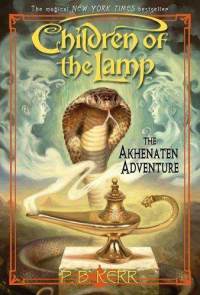P. B. Kerr, The Akhenaten Adventure
Children of the Lamp #1
reviewed by Danielle L. Parker

The Akhenaten Adventure Publisher: Scholastic (Orchard Books), 2004
Length: 355 pagesISBN: 0-439-67019-5 |
Though I’ve read thousands of books, the ones I discovered as a youngster are special. They’re like beloved relatives, worthy of a hug every time and fondly remembered. Yes, sure, now I’m too old for Journey to the Mushroom Planet. But it still gets a messy kiss from me. I can still vicariously enjoy the wonderful summer vacation of the children in Arthur Ransome’s famous Swallows and Amazons. E. Nesbitt and Edward Eager and their magic games. Alan Garner’s and Lloyd Alexander’s Celtic and Welsh stories. Howard Pease’s maritime yarns, which I think are entirely out of print now, and I wish I could find.
The Oz books, those completely homegrown American fairy tales, fascinated me, too. Then the joyful devouring of the first Andre Norton and Robert Heinlein space adventures. Dr. Seuss, so weirdly unique I didn’t know what to make of the first one I read, which was, as it happens, McElligott’s Pool.
And the greatest of those early discoveries are just as satisfying to an adult. Take Treasure Island and the Alice books. For a more modern example, take the Harry Potter stories. Perhaps the true test of great young adult literature is that it is enjoyable at any age.
Not, however, in the manner of a recent young adult fantasy I tried, which I’ll leave nameless here. That book was too adult for me. The teen in the story hung around with heavily made-up gal pals whose randy boyfriends scared me. The attitudes were surly. So when an elf shows up (though a suspiciously sexy one, a real teenage girl’s dream), I was relieved. But not for long. Oh no, the kids are hanging out in the bedroom again listening to loud music. Single mom doesn’t seem to mind they’ve closed the door now, too. Oh no! Get a chaperon up here!
I guess I’m too fuddy-duddy and faint-hearted for modern teen stories. I want one of those pioneer-era courting candles and an aunt’s gimlet eye on those kids.
Thus it was such a relief to pick up The Akhenaten Adventures, the first in P. B. Kerr’s Children of the Lamp series. You might know P. B. Kerr as Philip Kerr, who writes that wonderful Berlin Noir series (well, wonderful right up to Bernie’s Cuban excursion, where I had some problems with it, but that’s another book review...)
Now we’re back in the comfortable world of Edward Eager and E. Nesbitt. Magic happens, and children, thankfully only twelve-year old twins instead of attitude-laden teenagers I fear have lost their cherries already, have fantastic fun. John and Phlippa Gaunt are modern children, but they love their mom and dad and uncle. They’re respectful, and as obedient as good kids get. Which isn’t all that obedient in the small things, maybe, but all that could be asked for in what really matters.
John and Philippa live with their parents in New York City. Dad is an investment banker, and Mom a suspiciously graceful and gracious society light. The children’s precocious wisdom teeth appear. And suddenly, magic begins to happen.
The children’s eccentric British uncle Nimrod, who is strangely fond of devilishly red suits, appears in a dream. John and Philippa persuade their parents to send them to uncle Nimrod in London for their summer vacation, and John and Philippa discover they, too, are magical beings. They, like Mom and uncle Nimrod, are djinn: the Children of the Lamp.
Wonderful adventures ensue. The children, their uncle, his old friend Rakshasas and his complaining one-armed servant Groanin travel to Egypt, tangling with the ghost of a bad pharaoh (I always wanted to ask Akhenaten what caused those terrible love-handle thighs of his).
A bad djinn appears (a wonderfully snobby Old Etonian) to mouth over-the-top and not-very-scary classic villain dialogue at the children, before he’s corked in his bottle. The children race to the North Pole (freezing proving a good way to handle bad djinns), and finish up in an epic battle with the bad pharoah in the British Museum.
Good fun is had by all, and this timid reader (thank goodness I never had real-life teenagers to deal with) has a rip-roaring time, too.
Of course, P. B. Kerr’s book sits on the shelf comfortably next to Edward Eager and E. Nesbitt, well below the greats. But its simple innocence was sweet. I think perhaps not quite as fun as those aforementioned and similar authors to me, in part because those were stories of normal children who have magic adventures, and Kerr’s was a story of magic children having much easier magic adventures. It’s not quite the same, and somehow, because of that difference, not quite as good. Less vicariously satisfying, perhaps.
Some parts of the story (such as the trip to the North Pole) rush by us much too fast. And Kerr, while clearly having fun himself, does people his tale with fat American tourists, nose-in-the-air French persons who dine on foie gras and dislike bathing, shifty Egyptians and old-school-tie Englishmen who stop skullduggery for high tea. National stereotypes often have some unpleasant real-life roots to them. But I’m not sure I’d like to point those out to children in advance. I’d rather have them make up their own minds through real life experience, and hopefully, have them discover some happier truths.
But that’s a quibble. Kerr’s book is simple lighthearted joy for the most part, and even adults can suspend their suspicious minds and enjoy it. I’m ready for the next adventures of young John and Philippa.
Copyright © 2012 by Danielle L. Parker

